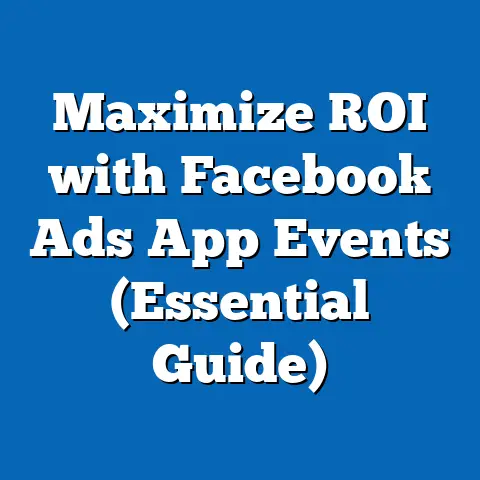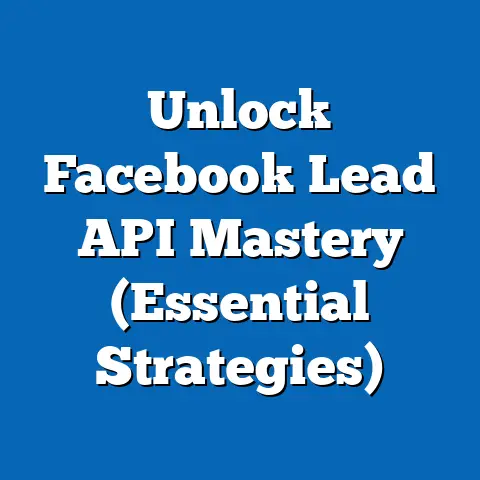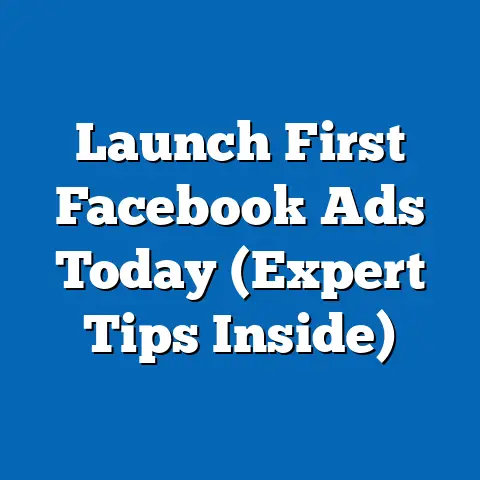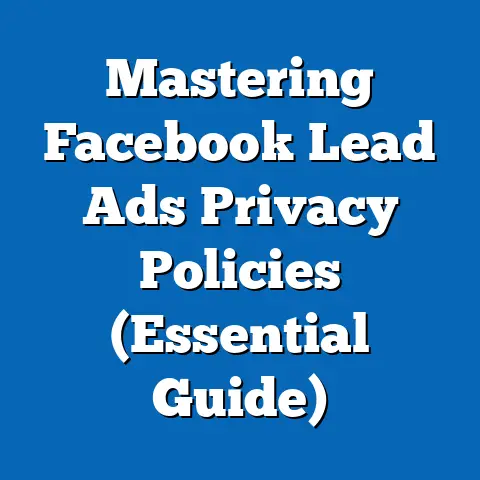Unlocking Emotion in Facebook Ads (Creative Strategy Guide)
As a digital marketing expert, I’ve seen firsthand the power of connecting with audiences on an emotional level. We’re not just selling products or services; we’re selling feelings, aspirations, and a sense of belonging. And when it comes to tapping into the deepest wellspring of human emotion, few things rival the power of family.
Think about it: family is where we learn our values, where we find unconditional love (most of the time!), and where we create memories that last a lifetime. It’s a universal theme that transcends cultures and demographics. That’s why family-centric themes can be incredibly effective in Facebook advertising.
I remember working on a campaign for a local bakery. Initially, they focused on showcasing their delicious pastries and cakes. While the ads were visually appealing, they lacked that special something to truly resonate with the target audience. That’s when we decided to shift the focus to family moments – a child’s birthday party with a custom cake, a grandparent sharing a pastry with their grandchild, a family enjoying a weekend brunch. The results were remarkable! Engagement skyrocketed, and sales followed suit.
Section 1: The Psychology of Emotion in Advertising
Advertising has evolved far beyond simply listing product features and benefits. Today, it’s about creating a connection, telling a story, and evoking an emotion. And few emotions are as powerful and enduring as those associated with family.
The psychology behind emotional marketing is rooted in the understanding that emotions influence our decisions, often more than logic or reason. Think about the last time you made a purchase. Did you carefully weigh all the pros and cons, or did you simply “feel” like it was the right thing to do? Chances are, emotion played a significant role.
How Emotions Influence Consumer Behavior:
- Memory: Emotional experiences are more likely to be remembered than neutral ones. This is because emotions trigger the release of hormones that enhance memory consolidation. An ad that evokes a strong emotion is more likely to stick in the viewer’s mind.
- Decision-Making: Emotions can override rational thought processes, leading to impulsive purchases or brand loyalty. A feeling of nostalgia, for example, can drive us to buy a product we haven’t used in years.
- Social Connection: Emotions are contagious. When we see others experiencing joy, love, or happiness, we’re more likely to feel those emotions ourselves. Ads that depict positive family interactions can create a sense of connection and belonging.
Statistics on Emotional Advertising:
- A study by Nielsen found that ads with emotional content have a 23% higher impact on sales than ads with rational content.
- Research by Harvard Business Review showed that emotionally connected customers are more than twice as valuable as highly satisfied customers.
- According to a report by Think with Google, emotional ads are twice as likely to be shared on social media.
These statistics underscore the importance of incorporating emotion into your Facebook advertising strategy. And when it comes to tapping into powerful emotions, family is a goldmine.
Key Emotions to Tap Into (and How They Relate to Family):
- Love: The unconditional love between parents and children, siblings, and spouses is a powerful motivator. Ads that depict loving family interactions can evoke feelings of warmth and affection.
- Nostalgia: Family traditions, childhood memories, and shared experiences can trigger feelings of nostalgia. Ads that reference these elements can create a sense of comfort and familiarity.
- Security: Family provides a sense of security and stability. Ads that emphasize the importance of protecting and providing for loved ones can resonate with parents and caregivers.
- Belonging: Family is where we belong. Ads that celebrate family unity and togetherness can create a sense of community and connection.
- Joy: Family celebrations, holidays, and everyday moments of laughter and joy can evoke positive emotions. Ads that capture these moments can create a sense of happiness and optimism.
Takeaway: Understanding the psychology of emotion in advertising is crucial for creating effective Facebook ads. By tapping into the powerful emotions associated with family, you can create a deeper connection with your audience and drive meaningful results.
Next Steps: Brainstorm ways to incorporate these key emotions into your upcoming Facebook ad campaigns. Think about your target audience and what aspects of family resonate most with them.
Section 2: Crafting Family-Centric Facebook Ads
Now that we understand the psychology behind emotional marketing, let’s get into the practical aspects of crafting family-centric Facebook ads. A successful ad isn’t just about slapping a picture of a family on a post; it’s about creating a cohesive message that resonates with your target audience on an emotional level.
Elements of a Successful Family-Centric Facebook Ad:
- Visuals: The images and videos you use in your ads play a crucial role in evoking emotion. Choose visuals that are authentic, relatable, and visually appealing.
- Imagery: Opt for photos or videos that depict genuine family interactions. Avoid staged or overly posed shots. Candid moments of laughter, connection, and love are more likely to resonate with viewers.
- Colors: Warm colors like yellows, oranges, and reds can evoke feelings of comfort, happiness, and love. Use these colors strategically in your visuals and ad design.
- Design: Keep your ad design clean and uncluttered. Focus on highlighting the emotional message of your ad. Avoid using too many fonts or graphics, which can distract from the core message.
- Copywriting: The words you use in your ad copy are just as important as the visuals. Craft headlines and body text that resonate with family experiences and evoke emotion.
- Headlines: Use headlines that are attention-grabbing and emotionally compelling. Examples:
- “Give Your Family the Gift of Adventure This Summer”
- “Create Memories That Last a Lifetime”
- “Protecting What Matters Most: Your Family’s Future”
- Body Text: Tell a story that resonates with your target audience. Share personal anecdotes, customer testimonials, or hypothetical scenarios that evoke emotion.
- “Imagine your family gathered around the table, sharing stories and laughter. Our [product/service] can help you create those cherished moments.”
- “As a parent, you want the best for your children. Our [product/service] can help you provide them with the tools they need to succeed.”
- Headlines: Use headlines that are attention-grabbing and emotionally compelling. Examples:
- Call to Action (CTA): Your CTA should align with the emotional storytelling in your ad. Instead of a generic “Shop Now” button, consider using CTAs that evoke emotion or offer a benefit to the family.
- “Create Your Family’s Story”
- “Give the Gift of Memories”
- “Protect Your Family’s Future”
- “Learn More About Family Protection Plans”
- Imagery: Opt for photos or videos that depict genuine family interactions. Avoid staged or overly posed shots. Candid moments of laughter, connection, and love are more likely to resonate with viewers.
- Colors: Warm colors like yellows, oranges, and reds can evoke feelings of comfort, happiness, and love. Use these colors strategically in your visuals and ad design.
- Design: Keep your ad design clean and uncluttered. Focus on highlighting the emotional message of your ad. Avoid using too many fonts or graphics, which can distract from the core message.
- Headlines: Use headlines that are attention-grabbing and emotionally compelling. Examples:
- “Give Your Family the Gift of Adventure This Summer”
- “Create Memories That Last a Lifetime”
- “Protecting What Matters Most: Your Family’s Future”
- Body Text: Tell a story that resonates with your target audience. Share personal anecdotes, customer testimonials, or hypothetical scenarios that evoke emotion.
- “Imagine your family gathered around the table, sharing stories and laughter. Our [product/service] can help you create those cherished moments.”
- “As a parent, you want the best for your children. Our [product/service] can help you provide them with the tools they need to succeed.”
- “Give Your Family the Gift of Adventure This Summer”
- “Create Memories That Last a Lifetime”
- “Protecting What Matters Most: Your Family’s Future”
- “Imagine your family gathered around the table, sharing stories and laughter. Our [product/service] can help you create those cherished moments.”
- “As a parent, you want the best for your children. Our [product/service] can help you provide them with the tools they need to succeed.”
- “Create Your Family’s Story”
- “Give the Gift of Memories”
- “Protect Your Family’s Future”
- “Learn More About Family Protection Plans”
Case Studies of Successful Family-Themed Facebook Ads:
-
Pandora Jewelry: Pandora frequently uses family-themed ads, particularly around holidays like Mother’s Day and Christmas. Their ads often feature mothers and daughters, or entire families, exchanging gifts of Pandora jewelry.
- Analysis: The ads evoke feelings of love, appreciation, and connection. The visuals are warm and inviting, and the copy emphasizes the sentimental value of the jewelry. The CTAs, such as “Shop Mother’s Day Gifts,” are clear and relevant.
- Key Learning: Pandora understands that jewelry is often given as a symbol of love and appreciation. By focusing on the emotional connection between family members, they create ads that resonate with their target audience.
-
Hallmark: Hallmark is a master of emotional marketing. Their Facebook ads often feature heartwarming stories about families overcoming challenges, celebrating milestones, or simply enjoying each other’s company.
-
Analysis: Hallmark’s ads are incredibly effective at evoking feelings of nostalgia, love, and connection. The visuals are authentic and relatable, and the copy is well-written and emotionally compelling. The CTAs, such as “Find the Perfect Card,” are relevant and encourage viewers to take action.
- Key Learning: Hallmark understands the power of storytelling. By sharing heartwarming stories about families, they create ads that resonate with their target audience on a deep emotional level.
-
Dove: Dove’s “Real Beauty” campaign is a prime example of emotional marketing. While not always explicitly family-focused, many of their ads feature mothers and daughters, or women of different generations, celebrating their natural beauty.
-
Analysis: Dove’s ads challenge traditional beauty standards and promote self-acceptance. The visuals are authentic and diverse, and the copy is empowering and inspiring. The CTAs, such as “Join the Real Beauty Conversation,” encourage viewers to engage with the brand and share their own stories.
- Key Learning: Dove understands the importance of authenticity and relatability. By featuring real women and celebrating their natural beauty, they create ads that resonate with their target audience on a personal level.
-
LEGO: LEGO ads often depict families building together, emphasizing the fun and creative aspects of the product. They highlight the bonding experience and the opportunity for parents and children to collaborate.
-
Analysis: These ads tap into the joy of shared experiences and the importance of family time. The visuals are bright and engaging, and the copy focuses on the benefits of playing together. The CTAs, like “Build Your Family’s Adventure,” are inviting and action-oriented.
- Key Learning: LEGO effectively positions its product as a tool for family bonding and creative expression, appealing to parents who want to spend quality time with their children.
-
Disney: Disney’s Facebook ads frequently showcase families enjoying their theme parks, movies, and merchandise. They focus on the magic and wonder of the Disney experience and the joy it brings to families.
-
Analysis: Disney excels at creating a sense of enchantment and nostalgia. The visuals are vibrant and captivating, and the copy evokes feelings of excitement and happiness. The CTAs, such as “Plan Your Family Vacation,” are highly appealing to families seeking a memorable experience.
- Key Learning: Disney leverages its strong brand identity and emotional connection with families to create ads that inspire dreams and encourage travel.
Pandora Jewelry: Pandora frequently uses family-themed ads, particularly around holidays like Mother’s Day and Christmas. Their ads often feature mothers and daughters, or entire families, exchanging gifts of Pandora jewelry.
- Analysis: The ads evoke feelings of love, appreciation, and connection. The visuals are warm and inviting, and the copy emphasizes the sentimental value of the jewelry. The CTAs, such as “Shop Mother’s Day Gifts,” are clear and relevant.
- Key Learning: Pandora understands that jewelry is often given as a symbol of love and appreciation. By focusing on the emotional connection between family members, they create ads that resonate with their target audience.
-
Hallmark: Hallmark is a master of emotional marketing. Their Facebook ads often feature heartwarming stories about families overcoming challenges, celebrating milestones, or simply enjoying each other’s company.
-
Analysis: Hallmark’s ads are incredibly effective at evoking feelings of nostalgia, love, and connection. The visuals are authentic and relatable, and the copy is well-written and emotionally compelling. The CTAs, such as “Find the Perfect Card,” are relevant and encourage viewers to take action.
- Key Learning: Hallmark understands the power of storytelling. By sharing heartwarming stories about families, they create ads that resonate with their target audience on a deep emotional level.
-
Dove: Dove’s “Real Beauty” campaign is a prime example of emotional marketing. While not always explicitly family-focused, many of their ads feature mothers and daughters, or women of different generations, celebrating their natural beauty.
-
Analysis: Dove’s ads challenge traditional beauty standards and promote self-acceptance. The visuals are authentic and diverse, and the copy is empowering and inspiring. The CTAs, such as “Join the Real Beauty Conversation,” encourage viewers to engage with the brand and share their own stories.
- Key Learning: Dove understands the importance of authenticity and relatability. By featuring real women and celebrating their natural beauty, they create ads that resonate with their target audience on a personal level.
-
LEGO: LEGO ads often depict families building together, emphasizing the fun and creative aspects of the product. They highlight the bonding experience and the opportunity for parents and children to collaborate.
-
Analysis: These ads tap into the joy of shared experiences and the importance of family time. The visuals are bright and engaging, and the copy focuses on the benefits of playing together. The CTAs, like “Build Your Family’s Adventure,” are inviting and action-oriented.
- Key Learning: LEGO effectively positions its product as a tool for family bonding and creative expression, appealing to parents who want to spend quality time with their children.
-
Disney: Disney’s Facebook ads frequently showcase families enjoying their theme parks, movies, and merchandise. They focus on the magic and wonder of the Disney experience and the joy it brings to families.
-
Analysis: Disney excels at creating a sense of enchantment and nostalgia. The visuals are vibrant and captivating, and the copy evokes feelings of excitement and happiness. The CTAs, such as “Plan Your Family Vacation,” are highly appealing to families seeking a memorable experience.
- Key Learning: Disney leverages its strong brand identity and emotional connection with families to create ads that inspire dreams and encourage travel.
Hallmark: Hallmark is a master of emotional marketing. Their Facebook ads often feature heartwarming stories about families overcoming challenges, celebrating milestones, or simply enjoying each other’s company.
Analysis: Hallmark’s ads are incredibly effective at evoking feelings of nostalgia, love, and connection. The visuals are authentic and relatable, and the copy is well-written and emotionally compelling. The CTAs, such as “Find the Perfect Card,” are relevant and encourage viewers to take action.
Dove: Dove’s “Real Beauty” campaign is a prime example of emotional marketing. While not always explicitly family-focused, many of their ads feature mothers and daughters, or women of different generations, celebrating their natural beauty.
Analysis: Dove’s ads challenge traditional beauty standards and promote self-acceptance. The visuals are authentic and diverse, and the copy is empowering and inspiring. The CTAs, such as “Join the Real Beauty Conversation,” encourage viewers to engage with the brand and share their own stories.
LEGO: LEGO ads often depict families building together, emphasizing the fun and creative aspects of the product. They highlight the bonding experience and the opportunity for parents and children to collaborate.
Analysis: These ads tap into the joy of shared experiences and the importance of family time. The visuals are bright and engaging, and the copy focuses on the benefits of playing together. The CTAs, like “Build Your Family’s Adventure,” are inviting and action-oriented.
Disney: Disney’s Facebook ads frequently showcase families enjoying their theme parks, movies, and merchandise. They focus on the magic and wonder of the Disney experience and the joy it brings to families.
Analysis: Disney excels at creating a sense of enchantment and nostalgia. The visuals are vibrant and captivating, and the copy evokes feelings of excitement and happiness. The CTAs, such as “Plan Your Family Vacation,” are highly appealing to families seeking a memorable experience.
Anatomy of a Family-Centric Ad (Example):
Let’s break down a hypothetical Facebook ad for a family vacation package to a beach resort:
- Visual: A high-quality photo of a family building sandcastles on a beautiful beach at sunset. The family is laughing and smiling, and the overall atmosphere is warm and inviting.
- Headline: “Create Unforgettable Family Memories on the Shores of [Resort Name]”
- Body Text: “Imagine your family waking up to the sound of crashing waves, spending your days building sandcastles, and enjoying delicious meals together under the stars. Our family vacation package includes [list of amenities] and is designed to help you create memories that will last a lifetime.”
- CTA: “Plan Your Family Getaway Today!”
Why This Ad Works:
- Emotional Connection: The ad evokes feelings of happiness, relaxation, and connection.
- Relatability: The image of a family building sandcastles is relatable to many people.
- Clear Value Proposition: The ad clearly outlines the benefits of the vacation package.
- Strong CTA: The CTA encourages viewers to take action.
Takeaway: Crafting effective family-centric Facebook ads requires careful attention to detail. Choose visuals, copy, and CTAs that resonate with your target audience on an emotional level.
Next Steps: Analyze your existing Facebook ads. Are you tapping into the power of emotion? If not, brainstorm ways to incorporate family-centric themes into your upcoming campaigns.
Section 3: Integrating Emotion into Your Brand Story
Creating individual family-centric ads is a great start, but to truly connect with your audience, you need to weave family narratives into your overall brand story. Your brand story is the narrative that defines your company, its values, and its mission. It’s what makes you unique and memorable.
Why Integrate Family Narratives?
- Humanizes Your Brand: Sharing stories about families using your products or services makes your brand more relatable and approachable.
- Builds Trust: Authentic family stories can build trust and credibility with your audience.
- Creates Emotional Connection: As we’ve discussed, emotions drive decisions. By integrating family narratives, you can create a deeper emotional connection with your target audience.
Authenticity and Relatability are Key:
When sharing family stories, it’s crucial to be authentic and relatable. Avoid creating contrived or overly sentimental narratives. Instead, focus on sharing genuine experiences that resonate with your target audience.
Ways to Showcase Real Families:
- Customer Testimonials: Feature real families who have used your products or services. Ask them to share their stories and experiences in their own words.
- User-Generated Content: Encourage customers to share photos and videos of their families using your products or services on social media.
- Behind-the-Scenes Content: Share behind-the-scenes glimpses of your company culture and the families who work there.
Maintaining a Consistent Emotional Tone:
Consistency is key when it comes to emotional marketing. Make sure your family narratives align with your overall brand values and emotional tone. If your brand is known for being playful and lighthearted, your family stories should reflect that. If your brand is known for being serious and trustworthy, your family stories should reflect that as well.
I once consulted with a financial planning firm that wanted to attract more families as clients. Their initial marketing efforts focused solely on the technical aspects of financial planning – investment strategies, retirement planning, and tax optimization. While this information was valuable, it didn’t resonate with their target audience on an emotional level.
We decided to revamp their brand story by incorporating family narratives. We featured real families who had benefited from their financial planning services, sharing stories about how the firm had helped them achieve their financial goals and secure their family’s future. We also created content that addressed common family financial concerns, such as saving for college, planning for retirement, and protecting their assets.
The results were dramatic. The firm saw a significant increase in inquiries from families, and their client retention rate improved as well. By integrating family narratives into their brand story, they were able to connect with their target audience on a deeper emotional level and build trust and credibility.
Tips for Integrating Emotion into Your Brand Story:
- Identify Your Core Values: What are the values that drive your company? Make sure your family narratives align with these values.
- Know Your Audience: What are their hopes, fears, and aspirations? Tailor your family stories to resonate with their specific needs and interests.
- Be Authentic: Share genuine stories that reflect real experiences.
- Be Consistent: Maintain a consistent emotional tone across all your marketing channels.
- Measure Your Results: Track your engagement rates, click-through rates, and conversion rates to see how your family narratives are performing.
Takeaway: Integrating family narratives into your brand story can help you humanize your brand, build trust, and create a deeper emotional connection with your target audience.
Next Steps: Review your existing brand story. Are you incorporating family narratives? If not, brainstorm ways to weave family-centric themes into your overall messaging.
Section 4: Targeting and Segmentation Strategies
Crafting compelling family-centric ads and integrating them into your brand story is only half the battle. To truly maximize your impact, you need to ensure that your ads are reaching the right audience. That’s where targeting and segmentation strategies come in.
The Importance of Audience Targeting:
Targeting allows you to focus your advertising efforts on the people who are most likely to be interested in your products or services. By targeting your ads to specific demographics, interests, and behaviors, you can increase your engagement rates, click-through rates, and conversion rates.
Facebook’s Targeting Features:
Facebook offers a wide range of targeting features that can help you reach the right audience for your family-oriented campaigns. Here are some of the most relevant:
- Demographics: Target users based on age, gender, location, education, and relationship status.
- Parents: Target parents of children of specific ages (e.g., parents of toddlers, parents of teenagers).
- Families: Target users who are married or in a relationship and have children.
- Interests: Target users based on their interests and hobbies.
- Family Activities: Target users who are interested in family vacations, family activities, or parenting.
- Specific Products: Target users who are interested in specific products or services related to family, such as baby products, children’s clothing, or family entertainment.
- Behaviors: Target users based on their online behavior.
- Purchase Behavior: Target users who have a history of purchasing family-related products or services online.
- Device Usage: Target users based on the devices they use to access Facebook (e.g., mobile devices, tablets).
- Custom Audiences: Create custom audiences based on your existing customer data.
- Website Visitors: Target users who have visited your website.
- Email List: Target users who are on your email list.
- Lookalike Audiences: Create lookalike audiences based on your existing customer data.
- Parents: Target parents of children of specific ages (e.g., parents of toddlers, parents of teenagers).
- Families: Target users who are married or in a relationship and have children.
- Family Activities: Target users who are interested in family vacations, family activities, or parenting.
- Specific Products: Target users who are interested in specific products or services related to family, such as baby products, children’s clothing, or family entertainment.
- Purchase Behavior: Target users who have a history of purchasing family-related products or services online.
- Device Usage: Target users based on the devices they use to access Facebook (e.g., mobile devices, tablets).
- Website Visitors: Target users who have visited your website.
- Email List: Target users who are on your email list.
- Lookalike Audiences: Create lookalike audiences based on your existing customer data.
Tailoring Emotional Messaging to Different Family Structures:
It’s important to remember that families come in all shapes and sizes. To truly resonate with your target audience, you need to tailor your emotional messaging to different family structures.
- Single-Parent Families: Focus on the challenges and triumphs of single parenthood. Highlight the strength, resilience, and love that single parents provide for their children.
- Multi-Generational Households: Focus on the importance of family traditions and the connection between different generations.
- LGBTQ+ Families: Celebrate the diversity of family structures and the love and commitment that LGBTQ+ families share.
Examples of Ad Campaigns Tailored to Specific Family Demographics:
- Campaign for a College Savings Plan (Targeting Parents of Young Children): The ad features a heartwarming image of a parent reading to their child. The headline reads, “Give Your Child the Gift of a Brighter Future.” The body text emphasizes the importance of saving for college early and the benefits of the college savings plan.
- Campaign for a Family Vacation Package (Targeting Families with Teenagers): The ad features a thrilling image of a family ziplining through a rainforest. The headline reads, “Create Unforgettable Adventures with Your Teenagers.” The body text highlights the exciting activities and experiences that the vacation package offers.
- Campaign for a Life Insurance Policy (Targeting Single Parents): The ad features a powerful image of a single parent hugging their child. The headline reads, “Protect Your Child’s Future, No Matter What.” The body text emphasizes the importance of life insurance for single parents and the peace of mind it provides.
I recall working with a children’s clothing retailer who initially ran broad, untargeted Facebook ads. While they saw some initial success, their ROI was underwhelming. We decided to implement a more targeted approach, segmenting their audience based on age, gender, and interests.
We created separate ad campaigns for parents of infants, toddlers, and preschoolers, each with tailored messaging and visuals. We also targeted users who were interested in specific clothing styles, such as organic cotton or superhero-themed apparel.
The results were astounding. The retailer saw a significant increase in their conversion rates and a dramatic improvement in their ROI. By targeting their ads to the right audience, they were able to connect with potential customers on a more personal level and drive meaningful results.
Takeaway: Audience targeting is crucial for maximizing the impact of your family-centric Facebook ads. Use Facebook’s targeting features to reach the right demographics, interests, and behaviors. Tailor your emotional messaging to different family structures to resonate with your target audience on a deeper level.
Next Steps: Review your existing Facebook ad campaigns. Are you targeting the right audience? If not, experiment with different targeting options to see what works best for you.
Section 5: Measuring Emotional Engagement
You’ve crafted compelling family-centric ads, integrated them into your brand story, and targeted them to the right audience. Now, how do you know if your efforts are paying off? That’s where measuring emotional engagement comes in.
Key Metrics to Track:
- Engagement Rate: This metric measures the percentage of people who interacted with your ad (e.g., liked, commented, shared, clicked). A high engagement rate indicates that your ad is resonating with your target audience.
- Click-Through Rate (CTR): This metric measures the percentage of people who clicked on your ad. A high CTR indicates that your ad is compelling and relevant to your target audience.
- Conversion Rate: This metric measures the percentage of people who took a desired action after clicking on your ad (e.g., made a purchase, filled out a form, signed up for a newsletter). A high conversion rate indicates that your ad is effective at driving results.
- Sentiment Analysis: This metric measures the overall sentiment of the comments and reactions to your ad. Positive sentiment indicates that your ad is evoking positive emotions.
- Brand Lift Studies: These studies measure the impact of your ads on brand awareness, brand perception, and purchase intent.
Tools and Methods for Analyzing Ad Performance:
- Facebook Ads Manager: This tool provides detailed data on the performance of your Facebook ads, including engagement rates, CTRs, and conversion rates.
- Google Analytics: This tool provides data on the behavior of users who visit your website after clicking on your Facebook ads.
- Social Media Listening Tools: These tools allow you to monitor social media conversations and track the sentiment surrounding your brand and your ads.
- A/B Testing: This method involves testing different versions of your ads to see which performs best. You can A/B test different visuals, headlines, body text, and CTAs to see what resonates most with your target audience.
Interpreting Data to Refine Future Campaigns:
Once you’ve collected data on your ad performance, it’s important to interpret that data and use it to refine your future campaigns.
- Identify What’s Working: What types of visuals, headlines, and body text are resonating most with your target audience? What targeting options are driving the best results?
- Identify What’s Not Working: What types of ads are underperforming? What targeting options are not driving results?
- Make Adjustments: Based on your findings, make adjustments to your ads and targeting options. Experiment with different approaches to see what works best for you.
I once worked with a non-profit organization that was running a Facebook ad campaign to raise money for children’s education. Their initial ads featured statistics about the importance of education. While the information was compelling, the ads weren’t generating the desired results.
We decided to revamp their ads by incorporating emotional storytelling. We featured stories about real children who had benefited from the organization’s programs, sharing their hopes, dreams, and challenges. We also included photos of the children and their families.
The results were remarkable. The organization saw a significant increase in donations and a dramatic improvement in their engagement rates. By tapping into the power of emotion, they were able to connect with potential donors on a deeper level and inspire them to take action.
We also used A/B testing to refine our ads. We tested different headlines, visuals, and CTAs to see what resonated most with our target audience. We found that ads that featured children’s faces and stories were more effective than ads that focused solely on statistics.
Takeaway: Measuring emotional engagement is crucial for optimizing your Facebook ad campaigns. Track key metrics, use the right tools, and interpret your data to refine your future campaigns.
Next Steps: Start tracking the performance of your family-centric Facebook ads. Use the data you collect to refine your ads and targeting options.
Conclusion
In the ever-evolving world of digital marketing, one thing remains constant: the power of human emotion. By tapping into the deep wellspring of emotions associated with family, you can create Facebook ads that resonate with your target audience on a personal level, build trust and credibility, and drive meaningful results.
I’ve seen it happen time and time again. Brands that embrace emotional storytelling and prioritize authentic connections with their audience are the ones that thrive in the long run.
So, I encourage you to embrace emotional storytelling in your Facebook ad strategies. Explore the potential of family-centric themes in your campaigns. Experiment with different visuals, headlines, and body text to see what resonates most with your target audience.
Remember, you’re not just selling products or services; you’re selling feelings, aspirations, and a sense of belonging. And when it comes to tapping into those emotions, few things rival the power of family.
Now, go forth and create some emotionally compelling Facebook ads that will connect with your audience on a deeper level and drive meaningful results! And don’t forget to share your success stories with me. I’m always eager to hear about the innovative ways marketers are using emotion to connect with their audiences.






